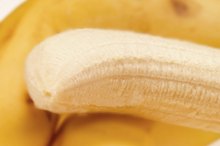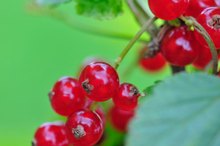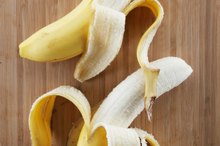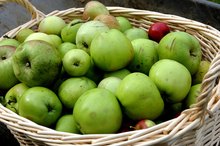Juices Low in Potassium
Potassium is a mineral naturally present in many fruits and vegetables that your body uses to support the functions of your heart, kidneys, muscles, nerves and more. While potassium can have many protective benefits, if you have kidney disease, your body may not be able to filter it properly. As a result, you may have to make some changes in food choices, including the juices you drink to reduce your overall potassium intake.
Significance
Because many fruits and vegetables contain potassium, you may need to avoid or limit certain fruit juices if you are restricting potassium intake. High-potassium food sources are considered to be those higher than 200 milligrams of potassium per serving, according to Drugs.com 2. A cup of prune juice has about 707 milligrams, making it a very high-potassium fruit juice. A half-cup of orange juice also is high in potassium -- about 236 milligrams per serving while a half-cup serving of grapefruit juice contains between 200 and 300 milligrams.
- Because many fruits and vegetables contain potassium, you may need to avoid or limit certain fruit juices if you are restricting potassium intake.
- A cup of prune juice has about 707 milligrams, making it a very high-potassium fruit juice.
Low-Potassium Juices
Eating Too Much Potassium
Learn More
If you enjoy a glass of fruit juice with breakfast or a meal, there are low-potassium options. Apple juice is considered a medium-potassium juice, containing about 147 milligrams of potassium per one-half cup serving, according to Drugs.com 2. Cranberry and grape juices also are lower-potassium juice servings when compared with prune and orange juice.
Serving Sizes
Serving sizes are important to consider when drinking low-potassium juices, because a low-potassium juice can quickly become a high-potassium option if eaten in excess. For example, the serving size for apple juice is one half-cup or 4 ounces. However, if you were to drink a full cup of apple juice, you would be getting almost 300 milligrams of potassium -- making apple juice a high-potassium choice. Practicing moderation is important when drinking fruit juices. If you have questions concerning a particular serving size or potassium content of a fruit juice, talk to your physician or dietitian about safe intake levels or alternatives to fruit juice 2.
- Serving sizes are important to consider when drinking low-potassium juices, because a low-potassium juice can quickly become a high-potassium option if eaten in excess.
Fluid Considerations
Potassium-Reduced Diet
Learn More
If you are restricting potassium content because you have kidney disease, you also may need to restrict your overall fluid intake. This is because the kidneys also are responsible for filtering fluids as well as potassium and minerals like phosphorus and calcium. If this is the case, you may need to limit the amount of fruit juice in your diet as well as other beverages.
Related Articles
References
- University of Michigan Hospitals and Health Centers; Low Potassium Food List; October 2007
- Drugs.com: Potassium Content of Foods List
- Hyson DA. A review and critical analysis of the scientific literature related to 100% fruit juice and human health. Adv Nutr. 2015;6(1):37-51. doi:10.3945/an.114.005728
- Orange juice. FoodData Central. U.S. Department of Agriculture. Published April 1, 2019.
- Zarfeshany A, Asgary S, Javanmard SH. Potent health effects of pomegranate. Adv Biomed Res. 2014;3:100. doi:10.4103/2277-9175.129371
Writer Bio
Rachel Nall began writing in 2003. She is a former managing editor for custom health publications, including physician journals. She has written for The Associated Press and "Jezebel," "Charleston," "Chatter" and "Reach" magazines. Nall is currently pursuing her Bachelor of Science in Nursing at the University of Tennessee.









